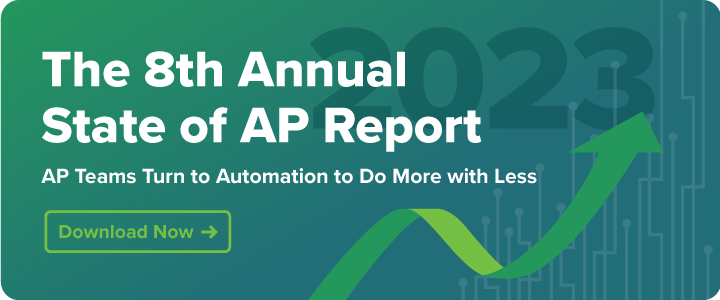An AP documentation management system serves as a single source of truth by maintaining master files of standard documents and storing them in an accessible location. In other words, it’s the system that keeps a company’s AP data accessible, organized, and up-to-date. In addition to keeping files organized, the right AP documentation management system should streamline the process of creating reports, save the AP team time and reduce the risk of human error.

What is Document Management in AP?
Document management in AP involves organizing all the paperwork that accumulates from any given transaction. Tracking invoice payments can involve receipts, expense reports, and other forms of documentation. Finance teams then use these documents later for cash forecasting purposes, reporting, accruals, and audits. Because AP teams need to maintain compliance and compile financial statements at regular intervals, it is critical that they establish a clear and detailed approach for storing and handling their information.
Historically, AP document management has been a paper-based process, resulting in management challenges. For example, a company with 200 monthly payments will need to keep track of 2,400 invoice-related documents a year, each of which must be filed and maintained. Keep in mind, that estimate doesn’t account for other documentation that supports the payment process, such as purchase orders, bank statements, and expense reports.
Modern AP document management systems are designed to streamline this process by storing all digital documents into one central location.This kind of platform not only makes it easy to access the right information, it also saves time during searches.
What are AP Documents?
AP documents are invoices, receipts, purchases orders, and other documents managed by accounts payable teams. The most common documents managed by AP teams include, but are not limited to, the following:
Invoices
These vendor-issued documents detail the items, quantities, and pricing for goods or services as well as the payment terms.
Purchase orders
These are the first official offer from the buyer specifying the type, quantity, and price of products or services.
Receipts
Within the context of Accounts Payable, receipts might refer to packing slips, bills of lading, dock receipts or any other proof-of-delivery documents that confirm the ordered quantity of goods has been received.
Check images
This is simply a digital copy of a check written by your company that has been posted to the vendor’s bank account.
Remittances
These are records of money that have been sent from one party to another. Buyers may need payment confirmations and bank remittances for closing, while suppliers need remittances to confirm payments are applied to the correct receivables.
Bank statements
These contain details of financial transactions that took place during a specified time period.
Contracts
Contracts include any legally binding agreements between your business and a vendor.
Expense reports
These reports provide an itemized list of expenses for which an employee was authorized to spend money on behalf of the organization. It provides information about how much money was spent, what items were purchased, and whether the expenditure was authorized.
In essence, documents managed by AP teams include anything that establishes a paper trail in support of an invoice or transaction, including files related to payment authorization and proof of payment.
Why Does Document Management Matter in AP?
In today’s digital world, teams must manage increasing loads of documents. For many organizations, this leads to a proliferation of documents stored in various locations and forcing users to search through multiple systems in order to find the right document.
Like all areas of finance, AP thrives when its documents are easily searchable, well organized, and accessible to all relevant users. However, when the volume of documents outgrows a system’s bandwidth, AP’s performance can pay the price.
In contrast, AP teams with a robust document management solution often achieve faster performance, higher visibility, and more trust in their organization’s financial reporting. A robust solution typically includes automated workflows, provides a single source of truth, and facilitates easier search and transparency.
Maintaining a solid purchasing paper trail through proper accounts payable document management is also vitally important for maintaining compliance, simplifying PO matching and reconciliation, and reducing common AP errors such as duplicate payments.
Challenges When Managing AP Documentation
AP documentation management can present many challenges for underprepared AP teams, especially when it comes to auditing. Here are several common examples:
Time-Consuming Processes
First and foremost, manual document management can be painfully time-consuming. Paper in general is slow, inefficient, and wasteful. Its incompatibility with hybrid and remote workforces can also impede digital back-office transformation initiatives.
The Rising Cost of Audits
Conducting financial audits can be an expensive endeavor, especially when they involve paying an outside team for their time. If documents aren’t organized properly prior to the audit, your business will spend extra money as auditors sift through available data. Fees related to audits also continue to rise, outpacing the rate of inflation.
The Great Reshuffle
Organizations are experiencing high turnover rates. Since accounts payable is often not viewed as mission-critical to a business, their hires may get backfilled at later dates. In the meantime, long-standing employees with important business knowledge may leave the organization, ultimately making a paper-based structure even more difficult to understand (let alone maintain). A paper-based structure may also dissuade younger AP staff who are accustomed to digital tools.
Machine-Readable Documents
Companies seeking to digitize and integrate automated processes sometimes run into challenges associated with making paper documents machine-readable so they can be scanned in without error. Even companies that leverage OCR technology can encounter difficulty getting line-specific data and information.
Increased Security Risk
Maintaining proper visibility and a single source of truth is a huge headache for most teams without a digital document management system. Beyond convenience and organization, paper-based systems negatively impact security–including both general cybersecurity as well as protection against payment fraud.
Paper-Based vs Paperless Documentation Management
If you’re looking to remain competitive today, the choice between a paper-based and a paperless document management system is simple given the challenges associated with paper.
Paperless documentation management environments make AP audits a breeze, with documents that are easy to find and search for. This environment also supports a hybrid workforce, as all invoices are scanned into the system and may be approved via email. Improved visibility is also a benefit, as it is simple to determine where an invoice is in the process.
| Paper-Based Management | Paperless Management | |
| Audits | Difficult to find related resources during audits | Documents are easy to find when it comes time for an audit |
| Hybrid Workforce | Incompatible and inconvenient for a hybrid workforces / Can result in lost or delayed invoices | Invoices are scanned into the system and can be approved via email |
| Visibility | Difficult to check the exact status of an invoice / Team members must look through filing cabinets to locate documents | Easy to see exactly where any AP document is in the system |
How to Store Invoices Electronically
Storing invoices electronically is a great way to stay organized, save space, and make it easier to find invoices when you need them. One of the best ways to easily store invoices electronically is to leverage an AP automation solution that stores invoices in a single location and organizes them. With MineralTree, invoices can either be submitted directly into the platform by the vendor through a vendor portal, or sent via email and scanned using OCR technology and human review to ensure 99.5% accuracy for every invoice. From there, invoices are organized and categorized by date, vendor, amount, approval status, and payment status, making it easy for businesses to find, pay, and file invoices.
How an AP Document Management Software Can Help
AP automation can help move companies to a paperless AP workflow in the following ways:
Make Documents Digital and Machine-Readable
By using OCR technology, you can convert your invoices into machine-readable electronic files. However, it’s important to choose the right vendor for this initiative, since some providers may be more focused on speed than accuracy.
MineralTree’s solution combines this technology with human review to ensure 99.5% accuracy. While some AP automation providers focus solely on the header info or the total invoice amount, MineralTree’s tool scans entire invoices to ensure that line items, account numbers, etc. are each coded correctly. Furthermore, all of this data is made available immediately upon invoice capture, allowing your team to create more accurate financial forecasts and detailed AP reports prior to posting invoices to your accounting system.
Increase Security Around Important Documents
AP automation securely enables access to documents and information anytime, anywhere. You can even share important information with third-parties or fellow employees, without granting access to your ERP system. With MineralTree, you can set up rule and role-based access for invoice approvals or grant temporary access to a vendor.
Access Documents From Anywhere
With AP automation software, all documents can be stored in the cloud in audit-ready and read-only format, meeting compliance standards and other requirements. Organizations that use AP automation don’t have to worry about document accessibility. Employees can access and read documents wherever they are working, whether they are in the office or not.
Case Studies: AP Document Management Systems
Attivo Moves to an Electronic Document Storage System
Software from Attivio, the Data Dexterity Company, provides users the right data to make better decisions. Amidst company growth, the team looked to partner with an AP automation solution to manage their influx of invoices and move them beyond a paper-based system.
Previously, invoices were entered manually into Attivo’s ERP system, where the team would then file the invoices in a cabinet and begin the payment process.
“At the end of each year, we were sending those invoices off to storage. We knew we would eventually need an electronic document storage system,” said Ashley Honeyman, Vice President of Finance.
By partnering with MineralTree, Attivio was able to move to an electronic document storage system. Through OCR technology and human review, invoices are now automatically converted to searchable PDF documents and stored digitally in the platform. Attivio no longer has to worry about its old filing cabinets, misplaced invoices, or the threat of human error from its processes.
The Baltimore Ravens Create a Centralized Point for Payment Data
Senior Payables Manager, Dana Cline and Director of Finance, Reba Koppelman functioned as a team of two, managing the entire AP process for The Baltimore Ravens. However, with over 2,500 vendors, they realized their accounts payable workflow was not scalable. Before adopting an end-to-end AP solution, they tried solutions that addressed part of the process.
“We were able to simplify a couple of the steps, but we weren’t seeing the type of return we were looking for in the investment we had made,” explained Koppelman. “Dana was still spending way too much time preparing check payments and trying to keep documents organized for future reference.”
By partnering with MineralTree, The Baltimore Ravens have been able to benefit from a bi-directional sync with Netsuite, which transfers data automatically between the two platforms. As a result, their AP team now has a centralized access point for payment-related information and various business departments can leverage this data with vendors and auditors.
Final Thoughts
MineralTree immediately captures invoice data at the moment it is received. With automated inbox and OCR scanning capabilities, as well as insight into analytics, aging schedules, and more, MineralTree has the features you need for a streamlined, robust document management system. Additionally, MineralTree allows you to store an unlimited amount of documents at no extra cost.
To learn more about how our easy-to-use, end-to-end, AP automation solutions can benefit your business, request a free demo today.
AP Documentation FAQs
How do I Organize my Files in Accounts Payable?
The best way to organize files in accounts payable is to leverage an AP automation solution that makes it easy to manage documents throughout the AP process, keep files organized, and streamline the process of creating reports.
What Records are Held by Accounts Payable?
Accounts payable departments typically store records including invoices, purchase orders, receipts, check images, remittances, bank statements, contracts, and expense reports.
What is the Accounts Payable Process?
The accounts payable process is the process of managing a company’s financial obligations to its creditors and vendors.
Will MineralTree Integrate with my ERP System?
MineralTree has the capability to integrate with a variety of ERP systems including Oracle (NetSuite, EBS, ERP Cloud, JDE, PeopleSoft); SAP; QuickBooks (Desktop, Online); Microsoft Dynamics (Business Central, Great Plains, Finance & Operations); and Sage (Intacct, 50, 100).
Does NetSuite have a Document Management System?
Yes, NetSuite has a document management system called the NetSuite File Cabinet. That said, with MineralTree’s TotalAP platform, data automatically syncs with your NetSuite accounts which provides users with a centralized location to quickly find documents.
Does QuickBooks Online have a Document Management System?
No, QuickBooks Online does not have a document management system. However, MineralTree TotalAP automation solution does! With MineralTree, data automatically syncs with your Quickbooks Online providing users with a centralized location to quickly find documents and enable teams to streamline and scale the entire AP process.



